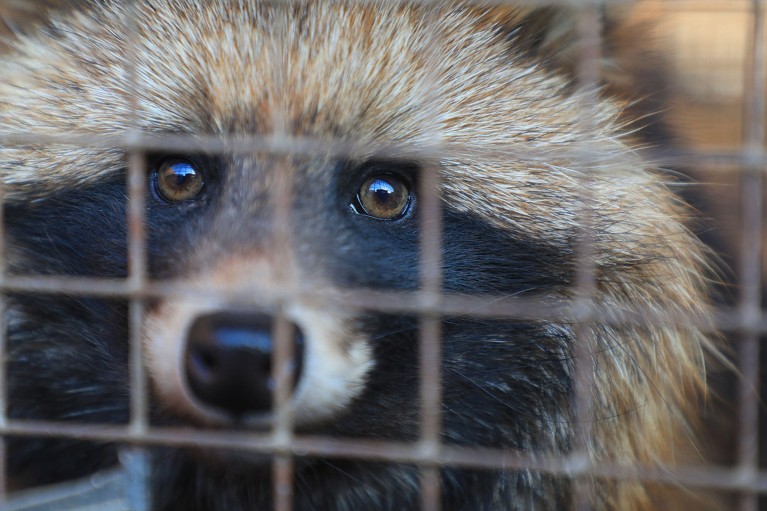
Raccoon dogs are among the animals susceptible to SARS-CoV-2 that were present at the Chinese market where the virus is thought to have jumped to humans.Credit: YongXin Zhang/Alamy
The quest to understand where the COVID-19 pandemic started has revealed fresh clues. Researchers have re-analysed data collected from a market in Wuhan, China, during the early days of the pandemic and found that animals there were infected with a virus – although they could not confirm what exactly caused the infection.
“The conclusion is convincing that there was infection in the animals,” says Spyros Lytras, an evolutionary virologist at the University of Tokyo. The results, which have not been peer reviewed, were presented at a conference, Preparing for the Next Pandemic: Evolution, Pathogenesis and Virology of Coronaviruses, in Awaji, Japan, on 3 December.
Many of the first COVID-19 cases to be identified were linked to Wuhan’s Huanan Seafood Wholesale Market. Some studies have reasoned that people brought the virus to the market, where they passed it on to others, while other studies have suggested that the market was the site of the first spillover events, in which animals with the virus first infected people1. Although these earlier studies established the presence of animals susceptible to the virus that causes COVID-19, and the virus itself, at the market, they were not able to confirm that the animals were infected with the virus2.
“The missing link in the whole zoonotic story has been the animal,” says Edward Holmes, a virologist at the University of Sydney in Australia. “If you can show there are infected animals at the market, then the story is complete,” he says, referring specifically to animals infected with a progenitor of SARS-CoV-2.
The latest analysis suggests that infected animals were at the market at the same time that early cases of COVID-19 emerged there. “This is one more piece of indirect evidence that suggests a connection of the origin of the SARS-CoV-2 pandemic with the Huanan market,” says Christian Drosten, a virologist at the Charité University Hospital in Berlin.
Most researchers agree that SARS-CoV-2 originated in animals. However, because a progenitor of the virus has not been found in an animal, some have continued to argue that the virus could have escaped — either by accident or through deliberate release — from the Wuhan Institute of Virology. A detailed report released by the Republican-majority select committee of the US House of Representatives earlier this week concluded that the pandemic “most likely emerged from a laboratory in Wuhan”.
Infected animals
Shortly after the Huanan market was shut down on 1 January 2020, a group of researchers from the Chinese Center for Disease Control and Prevention (China CDC) in Beijing visited the market and swabbed stalls, walls, bins, sewage wells and animal products stored in freezers. They sequenced DNA and RNA from those swabs and deposited that data into a genomic database.
Angela Rasmussen, a virologist at the University of Saskatchewan in Saskatoon, Canada, wanted to look more closely at the data for potential animal intermediates. She studied the genomic data of animals found at the market that are susceptible to SARS-CoV-2. These included American mink (Neogale vison), ermine (Mustela erminea), masked palm civets (Paguma larvata), raccoon dogs (Nyctereutes procyonoides), red foxes (Vulpes vulpes) and greater hog badgers (Arctonyx collaris).
When an animal is infected with a virus, its cells make copies of genes that produce proteins needed to fight off the infection. Studies of human cells and tissues have also identified a specific pattern of increased gene copying that is produced in response to infection with SARS-CoV-2 or other closely related viruses found in bats3. Rasmussen found the same pattern in the RNA profiles of humans who had been at the market and two of the susceptible animal species that were there: raccoon dogs and greater hog badgers.
The analysis finds evidence that the immune system of some animals had been activated, which supports the theory that they were infected, says Stanley Perlman, a virologist at the University of Iowa in Iowa City. But “it doesn’t substitute for finding the virus in an infected animal”.
Kei Sato, a virologist at the University of Tokyo, says he hopes to study raccoon dog tissue infected with SARS-CoV-2 and other related viruses to get a clearer view of which genes are copied in those animals in response to a coronavirus infection.



